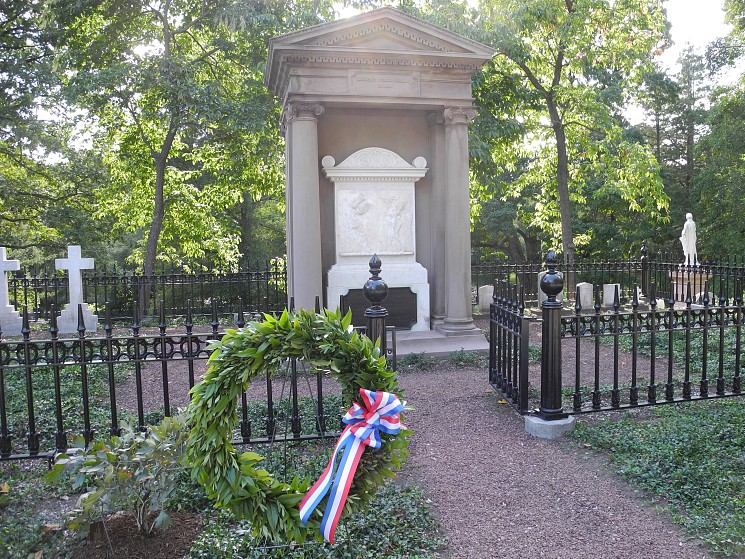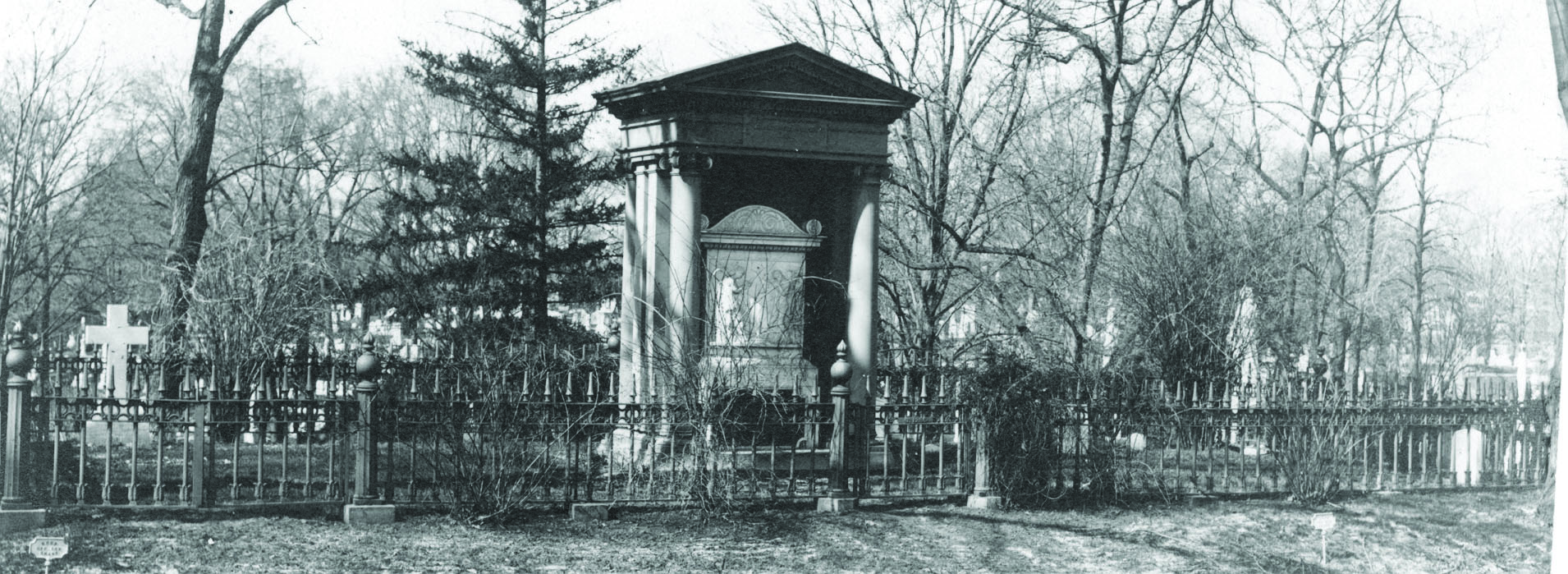Shaw Monument

In Memory: Colonel Robert Gould Shaw of the Massachusetts 54th
On Pine Avenue, across from the statue of the Sphinx, stands the celebrated memorial of Boston philanthropist and merchant Robert Gould Shaw (1776-1853). The monument has been a site of devotion for African American veterans as it also pays tribute to Shaw’s grandson, Colonel Robert Gould Shaw of the 54th Massachusetts Regiment. In September 1846, Shaw, a Boston philanthropist, merchant, and one of the city’s richest men, purchased an 800-square-foot family lot (Lot 1286, Pine Avenue) at Mount Auburn. Two years later he commissioned noted architect Hammatt Billings to design a family memorial to be built by local stone carver Alpheus Cary.
The front centerpiece of the Shaw monument includes an ancient Greco-Roman marble relief, dating from the first century, that Shaw imported from Athens. Two winged boreads from Greek mythology face each other, and relief work depicting poppy seed heads, associated with sleep, decorate the top of the monument. The memorial, styled on a classical Roman temple in Ionic marble and brownstone, stands 15 feet high.
The family memorial took on a national significance with the addition of a bronze plaque on the front of the monument in commemoration of Shaw’s grandson, Colonel Robert Gould Shaw (1837-1863). Colonel Shaw led the 54th Massachusetts Regiment in the Civil War at Fort Wagner in South Carolina. Other than the officers, the Regiment was comprised completely of Black soldiers—farmers, laborers, seamen, craftsmen, and two sons of Frederick Douglass, the famous orator, who championed the cause of Blacks serving in the war. Blacks were initially denied the right to enlist in the military, but, as the battle wore on, the demand for soldiers increased. The 54th Massachusetts Regiment would be among the first regiments of free Blacks to fight in the Civil War.
On May 28th, 1863, crowds cheered as the 1,007 Black uniformed soldiers and 37 White officers from the 54th marched on Boston Common, attended a ceremony at the State House, and eventually embarked on steamships headed for South Carolina. “You know how many eminent men consider a negro army of the greatest importance to our country at this time,” Shaw wrote. “How fully repaid the pioneers in the movement will be, for what they may have to go through!”[1]
On July 18th, Shaw led 600 men towards a Confederate fortification at Fort Wagner, a critical defense for Charleston. Shot through the heart, Shaw lost his life, and nearly half his soldiers were wounded, killed, or captured. Shaw’s father, Frank Shaw, wrote how grateful he was that the Colonel’s body remained with his fallen men at Fort Wagner.[2] The New York Tribune noted that “to this Massachusetts 54th was set the stupendous task to convince the white race that colored troops would fight,—and not only that they would fight, but that they could be made, in every sense of the word, soldiers.”[3]

The Shaw monument at Mount Auburn Cemetery has represented a revered memorial for veterans from the time it was erected in 1848.[4] “Ever since there have been Memorial Day services, the colored members of the Robert Gould Shaw Veterans’ Association . . . have lovingly tended in his memory an untenanted grave at Mt. Auburn Cemetery,” the Boston Daily Globe noted. As soldiers died after the war, the Association grew smaller. In 1922, two remaining members, veterans Edmund Walker, 89, and Cornelius Olivia, 87, visited the monument. The Globe reported, the men who were “hardly able to walk, with canes . . . nevertheless insisted on paying their tribute to their white leader and maintaining as long as possible the old custom.”[5]
Over time the monument suffered from extensive deterioration. A generous gift by S. Parkman Shaw, a descendant of Robert Gould Shaw, supported a comprehensive restoration to preserve and protect the cherished memorial and lot. Conservators gently washed the monument, filled joints with mortar, replaced missing pieces, and treated the corrosion on the bronze plaque that now clearly reads:
Greater love hath no man than this,
That a man lay down his life for his friends.
This is a stop on Mount Auburn’s
African American Heritage Trail
FOOTNOTES:
[1] Waugh, Joan, “‘It was a Sacrifice We Owed’: The Shaw Family and the Fifty-fourth Massachusetts Regiment,” in Martin H. Blatt, Thomas J. Brown, Donald Yacovone, eds., Hope and Glory: Essays on the Legacy of the Fifty-Fourth Massachusetts Regiment. Amherst: 2001, p. 68.
[2] See Lorien Foote, Seeking the One Great Remedy: Francis George Shaw and Nineteenth-Century Reform. Athens: Ohio University Press, 2003, p. 1.
[3] New York Tribune, September 8, 1865.
[4] In 1897 another memorial to Shaw, depicting soldiers in full uniform and designed by the renowned sculptor Augustus Saint-Gaudens, was erected across from the State House in Boston.
[5] Boston Daily Globe, May 31, 1922
Leave a Reply